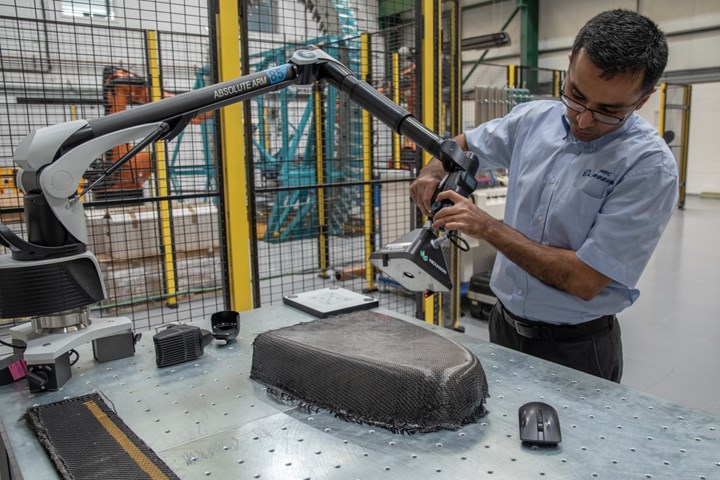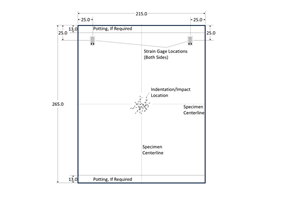Hexagon vision inspection eliminates manual inspection process
According to AMRC’s case study, Hexagon’s composite inspection technology uses 3D modeling to scan and map fiber orientation data, generating a 3D profile of the part being inspected.

Zeeshan Qureshi, lead research engineer on the Design Analysis and Composite Automation team at the AMRC Composite Centre. Source | AMRC
It was recently reported from a case study done by researchers at (AMRC; Rotherham, U.K.) that a vision inspection system using 3D modeling from Hexagon Composites (Alesund, Norway) could save composite manufacturers time and money by eliminating the manual inspection process of composite materials and parts.
“Quality checks during the layup process are vital but can take 70% or more of total machine time,” says Zeeshan Qureshi, lead research engineer on the Design Analysis and Composite Automation team at the AMRC Composite Centre. “It is a huge cost to our partners so we’re investigating automated in-process inspection systems that could help significantly decrease, or even eliminate entirely, manual inspection in order for them to achieve higher productivity in their factories.”
Qureshi points to the alignment of fibers when layering plies of unidirectional or woven fabric, and how detecting defects, from gaps and overlaps, to the presence of foreign objects and debris at a relatively early layup stage of production would much more efficient and cost-effective than identifying unacceptable weak points in the material once it is part of a completed component.
As a result, he says, the Composite Centre researched what systems were being successfully employed in related applications. This identified the capabilities of the Absolute Arm and its laser scanner options, products developed by Hexagon’s Manufacturing Intelligence division (North Kingstown, RI, U.S.).
“We discovered that Hexagon have developed a composite inspection system specially for measuring fiber orientations, which we believed could be a potential candidate for solving some of our inspection problems. They were quickly able to bring one such system to the AMRC to perform a case study — an Absolute Arm with RS5 Laser Scanner and a Vision System 3D,” says Qureshi.
The Vision System 3D is one of a number of solutions for composite fiber inspection that has been developed by Hexagon’s Vision and Composites product group in Aachen, Germany.
According to AMRC, the Vision System 3D is a camera-based sensor that can accurately detect the orientation of composite fibres using pixel-based algorithms. The system uses a metrological Absolute Arm for position referencing and, combined with scans made using the arm’s laser scanner and camera functionalities, this fiber orientation data can be mapped onto a three-dimensional model of the part being inspected using the dedicated Explorer 3D software platform.
“The system lets us validate the design and simulation work that we do at our desks to make sure our design intent is being manufactured, so it becomes a good validation step for our design and manufacture process,” says Qureshi. “We’re primarily using the system for weaving, braiding and preforming processes. Once we perform that initial manufacturing process, we can bring the part to the workstation and we would use the new inspection system to do a scan of the part to generate the 3D profile of the part we have.
“Using some of the advanced algorithms that are built into the software, we’re then able to determine fiber orientations that can give us an indication of some of the defects that are present in the part. We can take that information back into our design and analysis software to update our models with the data from the as-manufactured part in order to perform an analysis which we can then compare against the as-designed part. This provides valuable information for comparing the ‘real’ and ‘virtual’ environments in which we work.”
The Vision System 3D is one of a number of solutions for composite fiber inspection that has been developed by Hexagon’s Vision and Composites product group in Aachen, Germany.
“Working closely with the AMRC Composite Centre has been incredibly valuable to us here at Hexagon,” says Alexander Leutner, director of Vision at Hexagon. “It’s great to see our Vision System technology being used to enable the next leaps forward in the industrialisation of composite production, and the feedback we receive from the AMRC team has been invaluable to us as we continue to develop and improve our solutions.”
Qureshi says the next stage of the project is to investigate how the technology can be applied in other areas: “This is the first time we’ve had a metrology inspection system in-house. Now we’re hoping to help further develop both the hardware and software systems to make them robust enough to pick up some of the more complex defects that we’re hoping to achieve solutions for in the near future.”
He continues, “One of the advantages of having this system is that the sensor can be integrated with other composite layup machines as well, such as the AFP machine, braiding, stitching or 2.5D or 3D weaving machines that we have at the AMRC with the aim of achieving online inspection systems.”
Related Content
Cutting 100 pounds, certification time for the X-59 nose cone
Swift Engineering used HyperX software to remove 100 pounds from 38-foot graphite/epoxy cored nose cone for X-59 supersonic aircraft.
Read MoreDamage tolerance testing of sandwich composites: The sandwich CAI test
A new ASTM-standardized test method established in 2022 assesses the compression-loaded damage tolerance of sandwich composites.
Read MoreTroubleshooting thermoplastic composite stamp forming
Understand the basic science of TPC stamp forming, a manufacturing process steadily gaining momentum in aerospace and mobility applications thanks to its rapid forming, short cycle times and automated methods.
Read MoreASCEND program completion: Transforming the U.K.'s high-rate composites manufacturing capability
GKN Aerospace, McLaren Automotive and U.K. partners chart the final chapter of the 4-year, £39.6 million ASCEND program, which accomplished significant progress in high-rate production, Industry 4.0 and sustainable composites manufacturing.
Read MoreRead Next
Next-gen fan blades: Hybrid twin RTM, printed sensors, laser shock disassembly
MORPHO project demonstrates blade with 20% faster RTM cure cycle, uses AI-based monitoring for improved maintenance/life cycle management and proves laser shock disassembly for recycling.
Read MoreUltrasonic welding for in-space manufacturing of CFRTP
Agile Ultrasonics and NASA trial robotic-compatible carbon fiber-reinforced thermoplastic ultrasonic welding technology for space structures.
Read MoreScaling up, optimizing the flax fiber composite camper
Greenlander’s Sherpa RV cab, which is largely constructed from flax fiber/bio-epoxy sandwich panels, nears commercial production readiness and next-generation scale-up.
Read More












